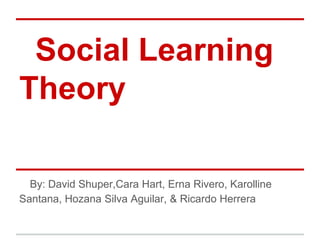
Social Learning Theory Explained
- 1. Social Learning Theory By: David Shuper,Cara Hart, Erna Rivero, Karolline Santana, Hozana Silva Aguilar, & Ricardo Herrera
- 2. Social Learning Theory • Social learning theory involves juveniles learning from and associating with others who participate in delinquent behavior. • According to social theory, juveniles learn to engage in delinquency from others through differential reinforcement, beliefs that are favorable to delinquency, and through modeling of delinquent behavior.
- 3. Reinforcement • Frequent and serious delinquent behavior is more likely to occur when it is constantly reinforced and rarely punished. • Reinforcement can either be positive or negative. • In positive reinforcement the behavior results in something good such as, money, approval of friends, and gain in social status.
- 4. Reinforcement cont. • Negative reinforcement is a behavior that results in the removal of something bad such as, the alleviation of peer pressure. • Reinforcement increases the possibility of the behavior and punishment reduces the possibility that such behavior will reoccur. • Individuals are less likely to engage in delinquency when they believe that the possibility of punishment is high and the possibility of reinforcement is low.
- 5. Beliefs • Beliefs are another mechanism that can foster juvenile delinquency. • Some individuals have beliefs that are favorable to delinquency; therefore they are more likely to commit more frequent and serious delinquent acts. • Some juveniles approve, justify and excuse violent acts if someone treats them in a disrespectful manner to uphold their respect and status within the community.
- 6. Beliefs cont. • The experience of certain strains increases the possibility of juveniles adopting such beliefs. • Individuals living in urban areas may believe they cannot reach success through legal means, so they view acts of theft, drug dealing, and violence as acceptable.
- 7. Imitating/Modeling • Imitation/ modeling is the notion that individuals participate in certain behaviors they have witnessed • Individuals who are exposed to delinquent models are more likely to partake in more frequent and serious delinquent acts themselves if they believe it will have positive results.
- 8. Imitating/Modeling cont. • For example, if a younger sibling views their older sibling participating in delinquent acts such as, fighting, selling drugs, and not going to school, and yet they are someone who is respected and liked by others in society eventually the younger sibling is going to imitate their criminal behaviors.
- 9. Warning signs for probation officers: 1. Believes violence is acceptable in solving most all situations. 2. Acts "macho" or "tough" which generally leads to violence. 3. Is a "thrill-seeker" or "risk-taker" 4. Always makes excuses or placing blame on others instead of taking responsibility for their own actions, thus to them, justifying the delinquent behavior. 5. Always looking for the quickest, easiest solution for problems and never wants to work for the things they desire
- 10. Why kids continue with or desist from delinquent behaviors? Continue: • Lack of parental guidance especially if living in abusive homes. • Several parents do not feel the need to "check up" on child if getting good grades, therefore not really knowing what he/she is really doing. • Constantly being labeled as a "bad kid", rather than trying to reach out and help. Desist: • Observing kids or loved ones get arrested, shot or dying due to delinquent behaviors. • Are aware of or have experienced the consequences of committing delinquent acts
- 11. What could change this behavior? • Monitoring what kids watch on television, media has a huge impact on a child. • Engage and show hope rather than automatically labeling as a "bad kid" or punishing. • Provide structure, encouragement and not leave kids alone too often, spending time can help interact and provide trust. • Promote mentoring programs, that will enable the child to interact with someone who may set a good example.
- 12. What could change this behavior? Cont. • Acknowledge and reward the child's good behavior. • Show interest in child's extra curricular activities. Get to know their peers and look for red flags. • Promote responsibility and its benefits by giving child chores, and rewarding them for completing each task assigned • Establish good rapport with the child. Communication is key to any relationship.